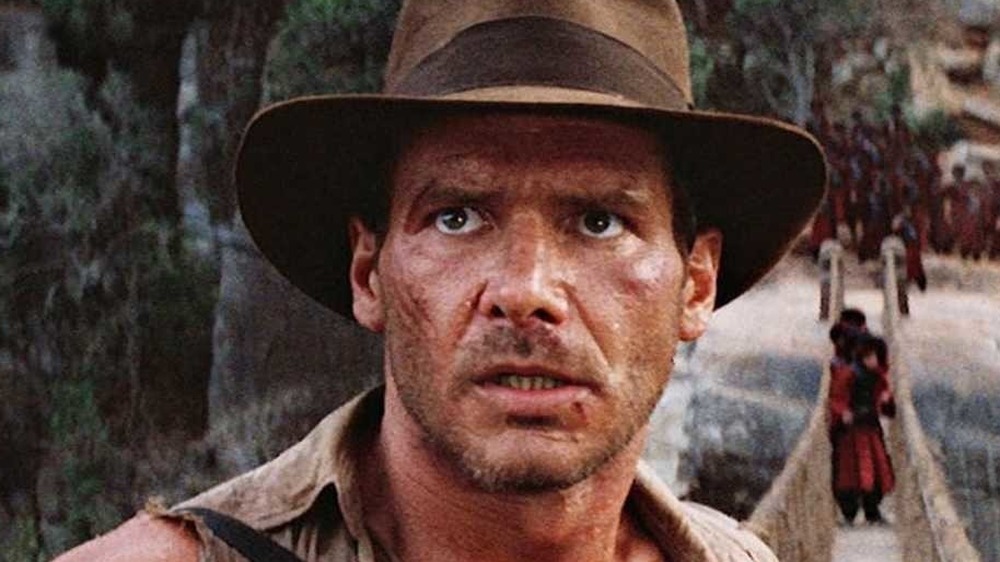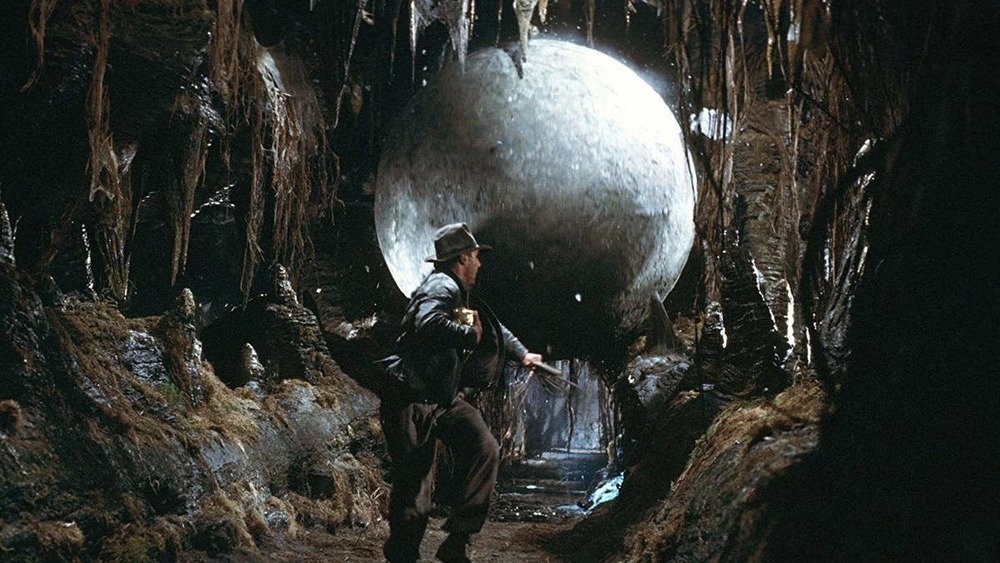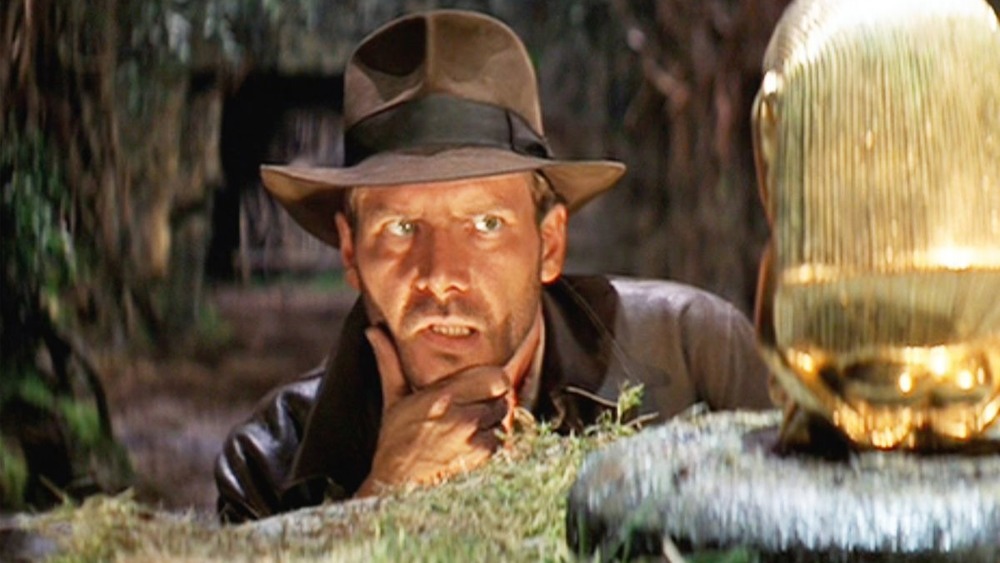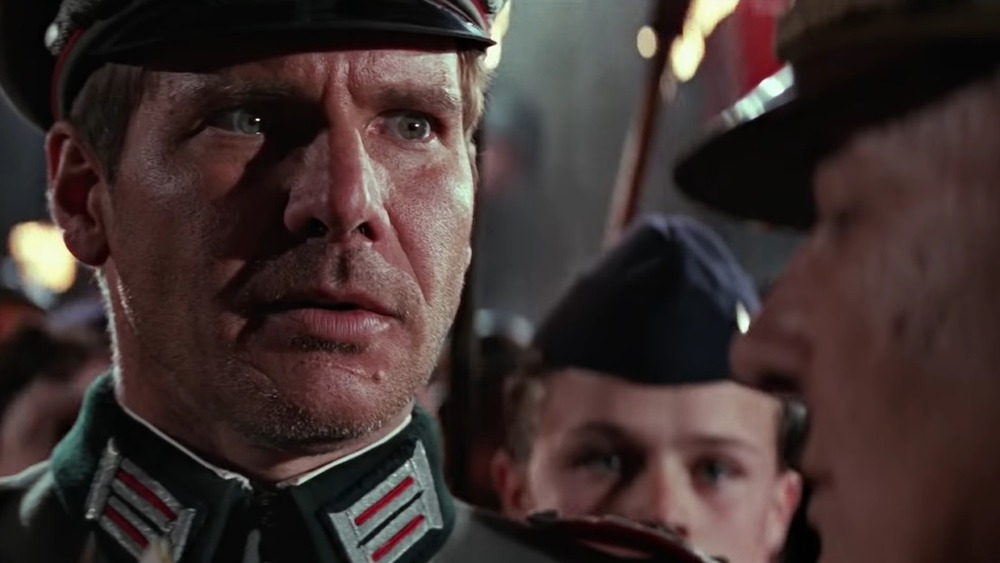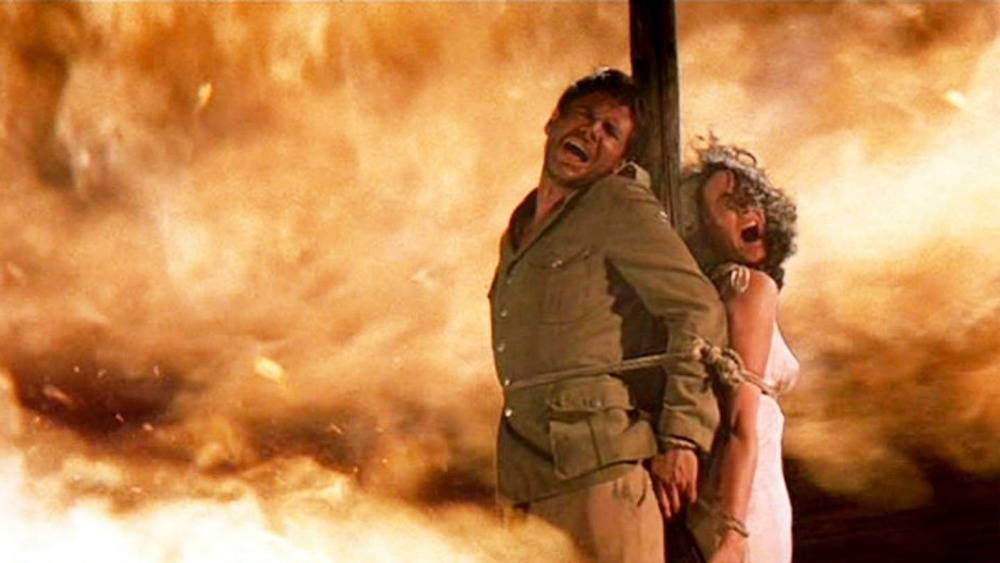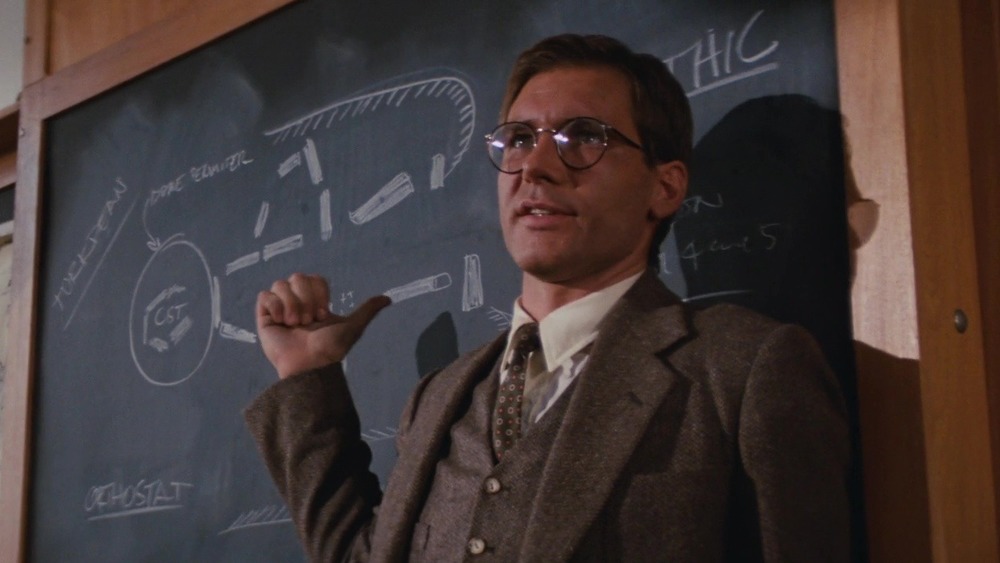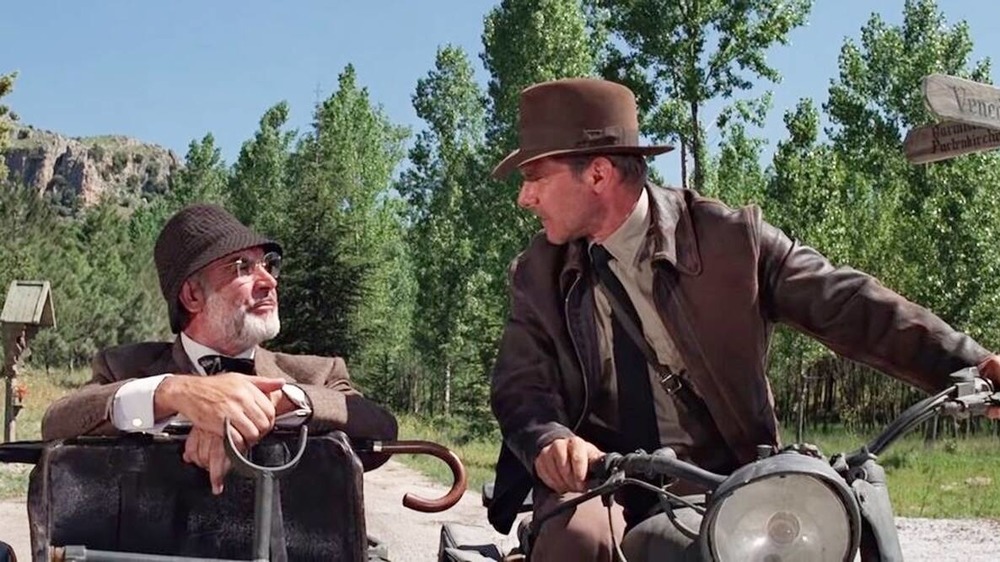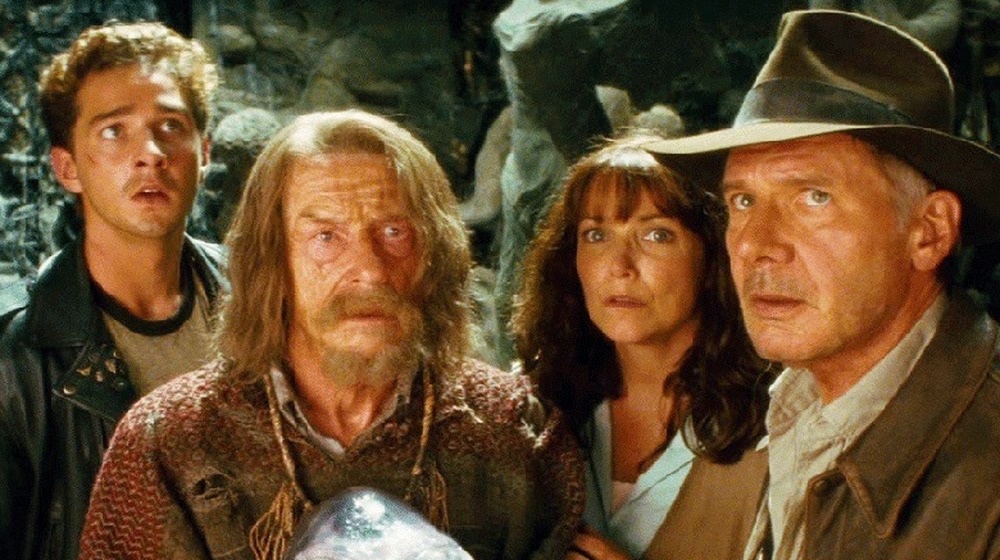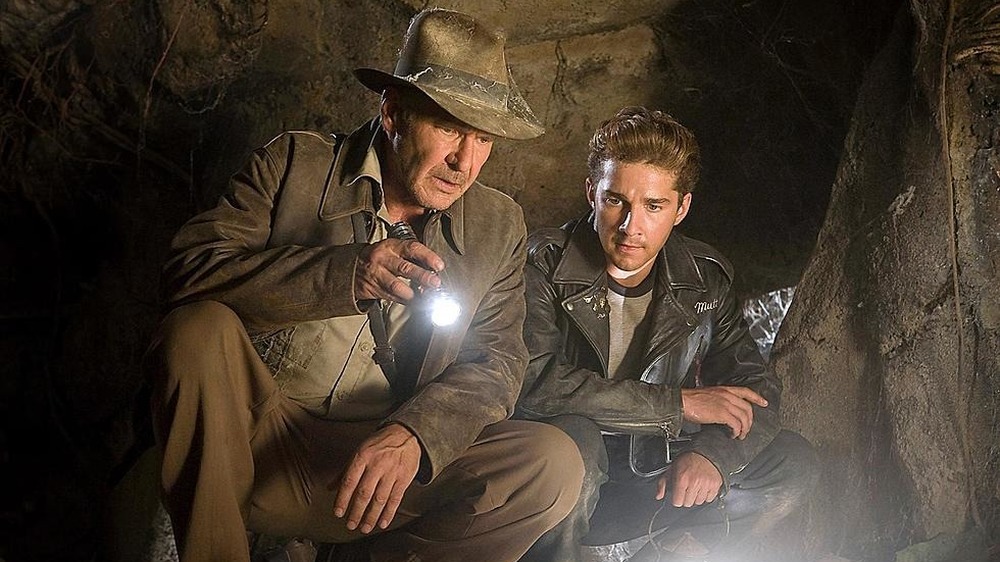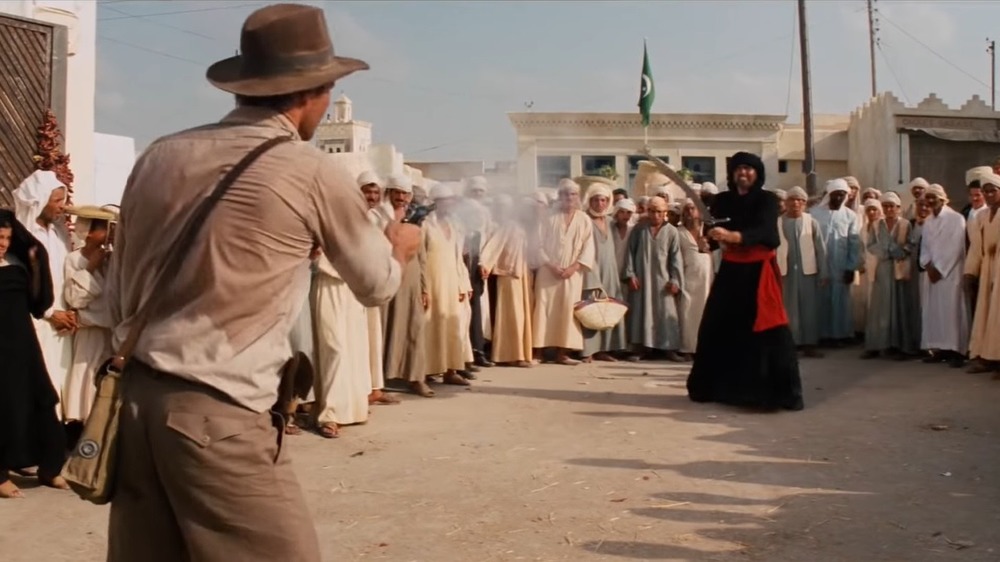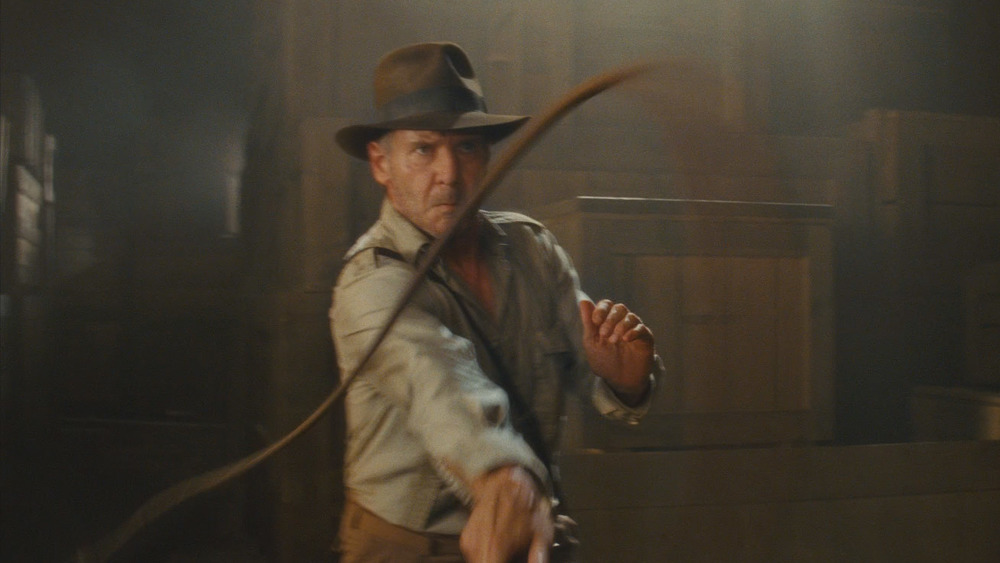Rules Indiana Jones Has To Follow In Every Movie
When you go see an Indiana Jones movie, you expect a few things. You expect lots of adventure, you're bound to hear that iconic John Williams theme, and Harrison Ford has to be playing the titular role. And these are just a few of the common details that abound in this far-reaching franchise. Even though Indiana Jones has faced a lot of different adversaries across various eras of human history, there's still a sense of unity in all of his films thanks to these common threads. In other words, you might even say this adventurous archaeologist has to follow a series of unofficial rules in each of his movies.
These rules stem from a variety of purposes, such as needing to separate Indy from other summer blockbuster characters or perhaps a desire from franchise creators to pay homage to the films that inspired the Indiana Jones flicks in the first place. But whatever the reason, once you see all the Indiana Jones movies, it becomes apparent that not only do these rules exist, but that they're key to this franchise offering up such consistent excitement.
Indiana Jones is a vulnerable hero
While some blockbuster heroes are defined by how many buildings they can destroy with one punch, Indiana Jones goes in a different direction. This adventurer has always had an element of vulnerability to him. In any of his fight scenes, Indiana Jones sweats, bleeds, stumbles, and expresses any other human imperfection you can exhibit. It's a trait that's helped to enhance the suspense of his globe-trotting escapades, as you're constantly reminded that a mortal man is the one engaging in these adventures.
It's a quality of Indiana Jones that's been ingrained into the character from the get-go, with the opening scene of Raiders of the Lost Ark establishing Indy as someone who becomes visibly exhausted while running away from pursuers, as well as being terrified by an airplane pilot's pet snake. Indy establishes his wit in this opening sequence, but he also cements his status as someone who can be as tired and scared as any of us.
Indiana Jones being someone whose vulnerability is apparent is a conscious choice per producer Frank Marshall. "Indy's a fallible character. He makes mistakes and gets hurt. He has a few more aches and pains now," Marshall said in a USA Today interview. "That's the other thing people like. He's a real character, not a character with superpowers." With that quality in place, it's made Indiana Jones a more tangible blockbuster character, one who's vulnerability has kept audiences glued to movie screens for decades.
His films have to be period pieces
Though a hallmark of 1980s cinema, Raiders of the Lost Ark was a period piece. The decision to set the character in the past was no accident. The film was meant to be an homage to the serial adventure films of the 1930s and 1940s that had inspired George Lucas and Steven Spielberg. "With both Star Wars and Raiders, I started out by asking myself, 'Gee, when I was a kid, what did I really like?”' George Lucas once explained (via The New York Times). ”Practically every movie star of the '30s has one movie like [Raiders], be it Alan Ladd or Clark Gable or whoever, playing a soldier of fortune in a leather jacket and that kind of hat."
In that same interview, Lucas also noted that this era of filmmaking was incredibly special to him, explaining, "That's a favorite period of mine." No wonder, then, that the creator of the Indiana Jones movies would incorporate this decade into Indy's adventures.
Because of how much the character owes to early 20th-century adventure filmmaking, it shouldn't be a surprise that the initial Indiana Jones trilogy occupied this era of history. These films didn't just pay tribute to 1930s action films, they occupied the very decade they honored! This affinity for setting Indiana Jones in period-era settings continued on with Kingdom of the Crystal Skull, which took Indy to the future ... but only up to the 1950s. Even as he moves forward, Indiana Jones is still a character that, for good reason, is stuck in the past.
Indiana Jones has a distrust for authority
Across Indiana Jones' adventures, there lies a recurring motif of Indy immediately disliking anyone in a position of authority. This can manifest in small ways, such as his extended frustrations against his mentor Professor Abner Ravenwood. But it also appears when he encounters large-scale baddies on his globe-trotting adventures. There are, of course, the Nazis he faces off against in Raiders and The Last Crusade, the powerful cult leaders in Temple of Doom, and the Russian antagonists of Kingdom of the Crystal Skull. Though all of them have varied goals, they're all united by being representative of powerful institutions.
Indy's villains are usually defined in this manner to emphasize the underdog nature of Indiana Jones as a character. This is even true with some of Indy's companions, particularly the presence of his father, Henry Jones Sr., who represents a sense of seasoned, refined authority compared to the rough-and-tumble nature of Indiana Jones. Much like how he actually bleeds when he gets into a fight, Indy constantly getting into arguments with people who have way more power at their back increases the suspense of his adventures. In the moment, it's easy to lose yourself in wondering if Indy will really be able to defeat a person with so much influence. Given how often he runs into unpleasant interactions with these kind of characters, it's no wonder that Indiana Jones has developed an intense distrust for authority.
He's always skeptical about the otherworldly
In Raiders of the Lost Ark, Indiana Jones is constantly told about the power of the Ark of the Covenant and how it has supernatural powers far beyond this realm. Such concerns fall on deaf ears, as Indy explicitly expresses skepticism over the actual power of this object. "I don't believe in magic, a lot of superstitious hocus pocus," Indy says to his cautious friend, Marcus. "I'm going after a find of incredible historical significance, you're talking about the boogie man." Of course, that initial sense of skepticism doesn't last forever. The Ark of the Covenant is eventually revealed to be as powerful of a mythical object as the legends said, which leads to the demise of the villains in Raiders of the Lost Ark, as well as Indy's doubt getting subverted.
Even after that adventure, Indiana Jones maintains a sense of uncertainty over the prospect of anything otherworldly or supernatural creeping into his life. His aims constantly remain more focused on grounded matters, such as protecting Marion Ravenwood or escaping villains holding him at gunpoint. Keeping Indy in this constant state of doubtfulness over these matters only enhances the specialness of the paranormal or sci-fi elements that do make their way into his adventures. But while Indy may have a hard time believing it, the Indiana Jones movies constantly show larger forces at work in this world.
Indiana Jones always works as a professor
Indiana Jones doesn't have an alter ego, but he does have a drastically different profession when he's not engaging in adventuring exploits. The character's primary occupation is working as a professor of archaeology at Marshall University. It's a unique profession for a summer blockbuster protagonist, a type of character who usually makes a living through more propulsive jobs like being a police officer or a billionaire inventor. Not so for Indy, who reflects his genuine interest in history by passing on his knowledge to the next generation.
While creators Steven Spielberg and George Lucas have refrained from giving a concrete explanation as to why Indy works as a professor, it could have something to do with the real-world people who possibly inspired Indiana Jones. For instance, some claim that archeologist and University of Chicago professor James Henry Breasted was a primary influence on the globe-trotting hero. But whatever the reason, Indy has remained a professor across all his adventures, even in Kingdom of the Crystal Skull, which makes it clear that his old boss, Dean Marcus Brody, has passed away. Even losing a pal like Brody couldn't keep Indy from teaching.
He always has new partners
For many iconic crimefighters, a constant sidekick is a must. Sherlock Holmes, for example, always has Watson by his side when he's sleuthing for clues. Robin Hood always has Little John and his Merry Men with him. Batman, meanwhile, has had a variety of different people inhabit the Robin persona in his superhero exploits. This is another element of the typical adventure hero archetype that Indiana Jones has shied away from. While the character has had sidekicks, they've always been one-off affairs. Indy has no time for permanent assistants.
In Indiana Jones and the Temple of Doom, the concept of Indy having a sidekick was introduced through the character of Short Round. This adolescent fellow was ditched for the next Indy adventure, The Last Crusade, which saw Indy's dad, Henry Jones Sr., taking on the role of sidekick. Finally, Kingdom of the Crystal Skull saw Indiana Jones getting his own biological son, Mutt, a 1950s greaser who helped his dad out on an adventure that eventually involved aliens.
A common trait across all these characters is their temporary nature. They never stick around for more than one movie. Short Round is never mentioned after Temple of Doom, Henry Jones Sr. is referenced as having passed away in Crystal Skull, and Mutt has already been confirmed to be absent from Indiana Jones 5. Perhaps the lone exceptions to this are the characters of Marcus Brody and Sallah, although they're less traditional sidekicks and more characters who just occasionally show up. In other words, Indy doesn't mind company on his adventures, but chances are good they won't be around for long.
Indy has strained relationships with his adventuring companions
It's a wonder Indiana Jones even brings anyone with him on his quests considering how he rarely gets along with his companions. Across all the Indiana Jones movies, the title character constantly butts heads with the people who go on grand adventures with him. This is established in the opening scene of Raiders of the Lost Ark, in which he's betrayed by Satipo as they try and escape a crumbling temple. Subsequent movies only showcase more strained relationships, with Temple of Doom being the most overt example of this phenomenon. Throughout the runtime of the movie, Willie Scott and Indiana Jones are constantly getting on each other's nerves and trading sharp barbs at one another.
For The Last Crusade, a longstanding fractured relationship between Indiana Jones and his father, Henry Jones Sr., informs the duo's strained dynamic as they navigate a hunt for the Holy Grail. A similar dynamic occurs in Kingdom of the Crystal Skull, when Indiana Jones has to work with his son, Mutt. This young greaser thinks he knows all the tricks of the trade while working alongside the gruff and experienced Indiana Jones, resulting in the two engaging in numerous moments of conflict. When you watch an Indiana Jones movies, you can expect many things, and just as common as big-scale visual effects is the fact that Indiana Jones won't get along with his traveling buddies.
The Indiana Jones movies feature father/son dynamics
Across the works of Steven Spielberg, stories about fractured families are common. This is due to Spielberg's own experiences as a kid with his parents getting a divorce. The event, which saw Spielberg developing a strained relationship with his own father, left such a lasting impact on the future filmmaker that it's worked its way into the majority of his films, including the light-hearted, escapist Indiana Jones movies. Specifically, the films engage in father/son dynamics that can either be idealized visions of what Spielberg would like these relationships to be or reflections of how complicated these relationships often are.
In Temple of Doom, for instance, Jones serves as a kindly father figure to Short Round. He's a dream-vision of a dad, the kind Spielberg feels he never got in his own childhood. In later films, though, the father/son dynamics become more intense. This is particularly true in The Last Crusade, when Indy is forced to spend an entire adventure with his own dad, who's far from an ideal parent. Kingdom of the Crystal Skull continues this trend by having Indy discover that he has a long-lost biological son named Mutt. The once-idealized father stand-in is now something closer to the nuanced reality of fatherhood. Even in Raiders of the Lost Ark, we learn that Indy has a strained relationship with his mentor/father figure, Abner Ravenwood.
No matter what kind of role Indy inhabits in this dynamic, father/son relationships run rampant throughout the Indiana Jones movies, a reflection of how deeply broken families run throughout Spielberg's works.
He isn't afraid to use blunt force
Indiana Jones is violent. Real violent. Whereas the franchise's sister series, Star Wars, has Jedi engaging in bloodless conflicts with lightsabers, Indy gets his hands into the mud and the blood when he's fighting Nazis or Russian spies. This combat style is most vividly rendered in a memorable moment from Raiders of the Lost Ark, where Indy is confronted by a daring swordsman who does an impressive display with his weapon ... only for Indy to casually shoot the guy dead.
Even his companion, Marion Ravenwood, gets in on the grisly action in Raiders by moving a plane's propeller around to turn one of Indy's adversaries into a pile of pulp and blood. That sort of nonchalant mayhem made Raiders of the Lost Ark stand out as a summer blockbuster and has managed to be a part of the Indiana Jones franchise throughout its movies.
This trait was especially present in Temple of Doom, to the point that it helped to inspire the PG-13 rating. Even after a nearly 20-year hiatus, his older exploits in Kingdom of the Crystal Skull saw Indiana Jones continuing to be a remorseless killer. This adventurer was still shooting poison darts into people's mouths, throwing punches, and firing off rocket launchers without any account for the cost of human life. While Indy may have an affinity for preserving ancient artifacts, he's far less considerate when it comes to shedding the blood of his enemies.
Indiana Jones must always carry his whip and hat
There are many things people attribute specifically to Indiana Jones, but easily the most distinctive feature of this famous character is his costume. No matter where you go in the world, that fedora and that whip are easily recognizable as items only Indiana Jones could carry. The whip is especially unique, particularly among American action movie heroes, who tend to use either their fists or a gun to take out their enemies. Indy isn't above using either of those items in a scuffle, but his proclivity for a bullwhip immediately sets him apart from his contemporaries.
By committing to that weapon and that hat, Indiana Jones has the kind of immediately iconic outfit that few film characters can claim to have. The ensemble has also proved to be an enduring part of the saga as a whole. Across all his films, Indiana Jones carries this outfit with him. Though he may temporarily change into different attire when teaching as a professor or attending fancy dinners, it isn't long before Jones returns to that famous get-up. It's something even the filmmakers behind these movies recognize could only belong to this character. At the end Kingdom of the Crystal Skull, it's teased that Mutt Williams is taking on the fedora ... and then subverted at the last minute by Indy stealing the hat back. It's a humorous moment that recognizes how this costume truly belongs to the one and only Indiana Jones.
